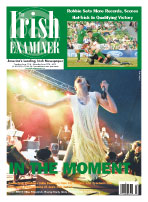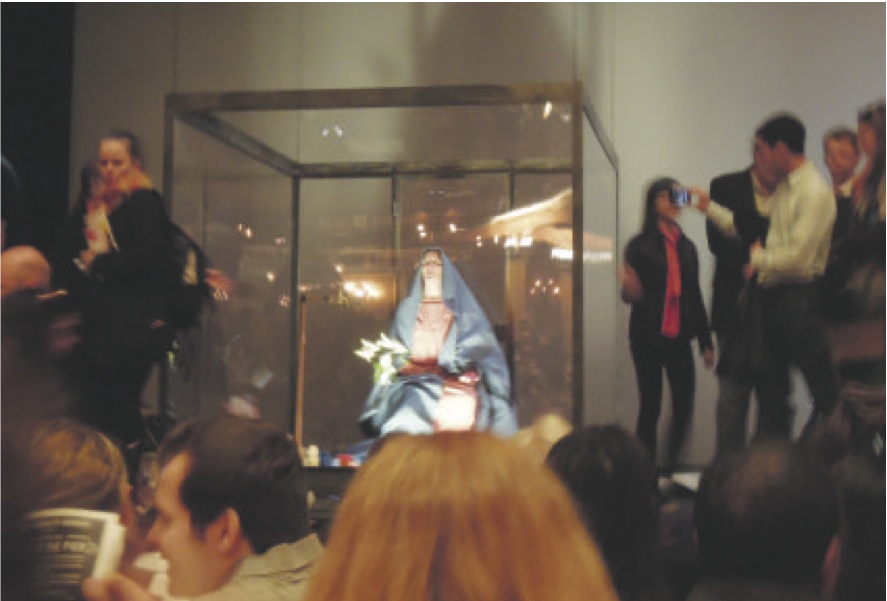


SERVICES
Tuesday April 23, 2013
My Son, The Messiah
During the fifteen-minute preshow Mary Fiona Shaw) sits in regal robes, like a statue in what looks like a glass box (Gwen Orel) By Gwen Orel So anguished is Mother Mary about the fate of her son that she can't bring herself to speak his name. Fiona Shaw plays Mary, in Colm Tóibín's searing play "Testament of Mary," as a woman with a bitter laugh, outbursts of rage, and penetrating insight into her own situation. It begins years after the death of Jesus, as her unseen "guardians" essentially hold her prisoner while they write the gospels. When the 90-minute play ended, the audience was quiet, and then rose almost as one for Shaw. She had to come back on three times. The applause was completely deserved. Shaw's performance is a thing of beauty and power, something so scorching and original that it's hard to describe. Yet one must try. The play was written for Irish actress Marie Mullins, and appeared at the Dublin Theatre Festival as "Testament." Tóibín wrote it as a novella, published in 2012, which was enthusiastically received. We spoke to the playwright last week and he told us that because of his childhood, the imagery and language of Catholicism could be summoned up at a moment's notice. Some of that imagery appears during the fifteen-minute preshow, which informs the play that follows, so plan to attend. In what looks like a glass box, Mary sits in regal robes, like a statue. Around the outside of the box are candles and icons. A live vulture perches onstage. The audience is invited to walk up to the stage and take pictures. When the play is about to begin the ushers warn that no more pictures can be taken, and the doors shut. Do not be late: here is no late seating, nor a television in the lobby on which one can see the play. The box then flies away. Stagehands take away the candles. Shaw takes off her robes to reveal modern clothes (designed by Ann Roth) underneath. She takes the vulture offstage, then returns. The play begins. Tom Pye's set is spare and poetic. There is a tree with a wheel at its top hanging from the ceiling, suspended above the stage by a few feet, with no roots; a faucet; chairs; brooms. The black back walls open to reveal lighter walls behind them. One side of the set appears to be stone, the other wood. Mary begins by telling us how "they" visit more often, and how she can sense a "brutality boiling in their blood." They are writing what happened, and tell her it will change the world. "All of it?" she replies, which gets a laugh. Somehow her Mary finds humor in the incredulity she has towards the revisiting of what felt to her like a nightmare, watching a beloved son, who was "not a misfit," unlike the people he gathered around him, become pompous, arrogant in his miracle-working, and killed in a horrific way. This is no Mary that finds peace in the realization that her son died to save the world. This is a story of betrayal - a cousin, who is actually not related at all, Marcus, seeks her out to warn her, she recalls, and that cousin is a little too closely integrated with those who will arrest him. Each miracle she hears about hits her like the thud of a hammer on a nail. Mary returns often to a story of a man feeding live rabbits to a bird of prey trapped in a cage too small for it, while she watched her son hang on the cross. The bird pecked cruelly at the rabbits but did not eat them, causing the man to smile. It's a horrible image - both predator and prey are tortured, and the sadism of the man is unthinkable - and yet it gave Mary some kind of comfort while it was happening, because it was a distraction. Throughout the play Mary washes herself, fills a bucket, finally strips and bathes herself. The baptism does not seem to cleanse her, though. When briefly naked, there's still a holiness about her like a shield. It's not holiness borne of love but of rage. Mary smokes. She describes threatening the disciples when they overstep their boundaries. She's altogether fierce and commanding. Director Deborah Shaw brings out every drop of theatricality in power in Tóibín's poetic prose, so that never do we feel we're watching a literary monologue so much as viewing the world from the anguish of a mother. Mary can't forget anything, she says: "memory fills my body as much as blood." As Mary tells the story, the miracles are close to being abominations - causing a lame man to walk on the Sabbath day, for example, is a sort of sacrilege. And the resurrection of Lazarus has more in common with the "The Monkey's Paw" by W.W. Jacobs in which parents wishing for a dead son to return panic at the sound of someone knocking. There is no real return from the dead except to a half-life; Lazarus weeps and moans. It's chilling. Whenever Mary recalls her son giving a Biblical pronouncement, she holds out one arm and the other is on her shoulder, as if she's doing Michael Flatley's pose. And yet, her love makes the horror of the crucifixion, the hammering, the holes for the crosses, the human agony, the words she can't hear (if Jesus said to forgive them, it's not in this play) impossibly brutal. In her telling, Mary sometimes shouts, or a cry bursts from her. At one point she lies on the table with a bottle. One gets the feeling of a woman trapped as much as the bird in the cage was trapped, although she understands her guardians think they are caring for her. She and the others fled at the last minute while Jesus was on the cross, aware they were about to be hunted, Mary says, so the imagery of her holding the body is a lie and yet as she retells the story of that lie, she holds a coat, as if she's the Piéta. The resurrection is a dream she shared with the disciple Mary. And yet we see an olive tree appear out of the well. "Testament of Mary" is chill- ing; beautiful and cold. There's a great mystery at its heart, and there is tremendous love. In this, Tóibín's play is both requiem and prayer. "Testament of Mary" opened on Monday, April 22, and runs at the Walter Kerr Theatre, 219 W. 48 St, through June 16.
Gwen Orel runs the blog and pod-cast, New York Irish Arts. |
CURRENT ISSUE

RECENT ISSUES


SYNDICATE
[What is this?]
POWERED BY

HOSTED BY

Terms of Service | Privacy Policy
Website Design By C3I






